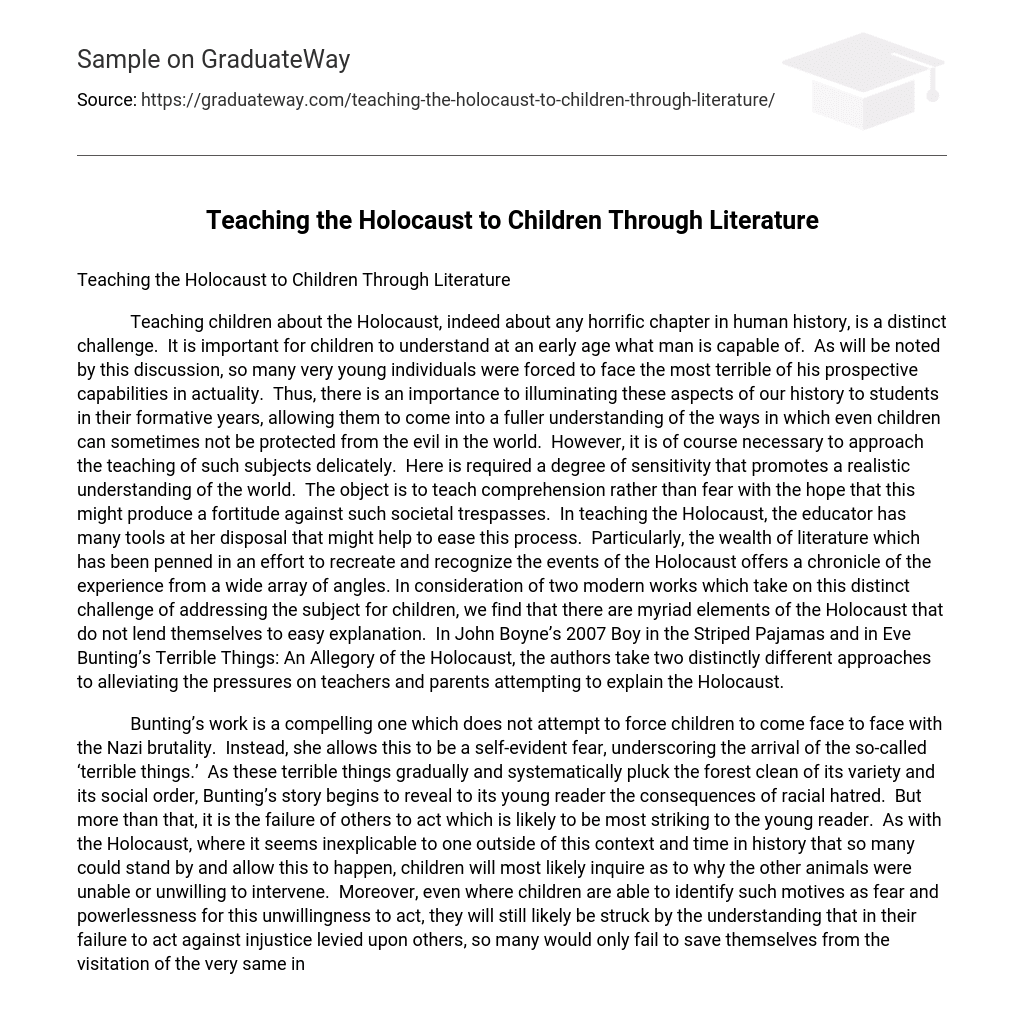Teaching children about the Holocaust, indeed about any horrific chapter in human history, is a distinct challenge. It is important for children to understand at an early age what man is capable of. As will be noted by this discussion, so many very young individuals were forced to face the most terrible of his prospective capabilities in actuality. Thus, there is an importance to illuminating these aspects of our history to students in their formative years, allowing them to come into a fuller understanding of the ways in which even children can sometimes not be protected from the evil in the world. However, it is of course necessary to approach the teaching of such subjects delicately. Here is required a degree of sensitivity that promotes a realistic understanding of the world. The object is to teach comprehension rather than fear with the hope that this might produce a fortitude against such societal trespasses. In teaching the Holocaust, the educator has many tools at her disposal that might help to ease this process. Particularly, the wealth of literature which has been penned in an effort to recreate and recognize the events of the Holocaust offers a chronicle of the experience from a wide array of angles. In consideration of two modern works which take on this distinct challenge of addressing the subject for children, we find that there are myriad elements of the Holocaust that do not lend themselves to easy explanation. In John Boyne’s 2007 Boy in the Striped Pajamas and in Eve Bunting’s Terrible Things: An Allegory of the Holocaust, the authors take two distinctly different approaches to alleviating the pressures on teachers and parents attempting to explain the Holocaust.
Bunting’s work is a compelling one which does not attempt to force children to come face to face with the Nazi brutality. Instead, she allows this to be a self-evident fear, underscoring the arrival of the so-called ‘terrible things.’ As these terrible things gradually and systematically pluck the forest clean of its variety and its social order, Bunting’s story begins to reveal to its young reader the consequences of racial hatred. But more than that, it is the failure of others to act which is likely to be most striking to the young reader. As with the Holocaust, where it seems inexplicable to one outside of this context and time in history that so many could stand by and allow this to happen, children will most likely inquire as to why the other animals were unable or unwilling to intervene. Moreover, even where children are able to identify such motives as fear and powerlessness for this unwillingness to act, they will still likely be struck by the understanding that in their failure to act against injustice levied upon others, so many would only fail to save themselves from the visitation of the very same injustice. And for the millions of Europeans who surrendered their way of life as a byproduct of that which they allowed to happen to the Jews and other targeted groups,
It is interesting to note that just as Bunting and Boyne make something of a similar decision, paying the focus of their respective narratives not necessarily to the suffering that was directly afflicted upon the Jews but to the experience of observing this suffering. In Boyne’s text, this experience is channeled through the most innocent of eyes. For the young Bruno, it is difficult to understand quite a few things about the new world in which his Germany has come to live. As the son of an S.S. guard, he and his family relocate from a comfortable and mysterious mansion into a small quarters on the grounds of a concentration camp. This considerable downgrade in living is accompanied by his new observations of the ‘people in the striped pajamas,’ whom his sister tells him are distinctly different or ‘opposite’ from the Germans.
In this explanation, the reader begins to gain the type of understanding of the racial implications of the Holocaust which are also central to the Bunting text. But even more distinguishing in this text is its establishment of a wicked and inhumane world through the perspective of a child who couldn’t possible make sense of the situation. By selecting a protagonist who is unlikely to be seen as implicated but is yet removed enough from the experience of affliction to fully understand its meaning as had the young Jews such as Shmuel. When he befriends the latter, his innocence is only magnified, as he seems to show no understanding of the peril and terribleness of his friends situation. This is a useful way of introducing the subject to the young reader, who will most assuredly enter into the subject with something of the same innocence but who will remain steadfastly aware of the true danger facing Bruno. The resolution, in which an S.S. guard finds that his son has been accidentally included amongst those ‘opposites’ who had been sent to the gas chambers, the child is left with a shocking turnabout of events.
In both of the texts discusses, there is a diligence in committing to the brutality of the subject matter. Indeed, neither text flinches from the premise of death or of disappearance, both of which must necessarily be implied or demonstrated if one is to understand the implications of the Holocaust. Without appealing to any manner of sensationalism, each story finds an inherently allegorical way to approach a subject that in its explicit description may be overwhelming to children. By introducing in a manner that is comprehensible and at least gentle enough to be palatable, each text helps to introduce children to the themes of racism, social responsibility and human cruelty which all must be understood before one can begin to come to grips with the realities of the Holocaust.
Works Cited
Boyne, J. (2007). The Boy in the Striped Pyjamas. David Fickling Books.
Bunting, E. (1989). Terrible Things: An Allegory of the Holocaust. Jewish Publication Society of Review.





